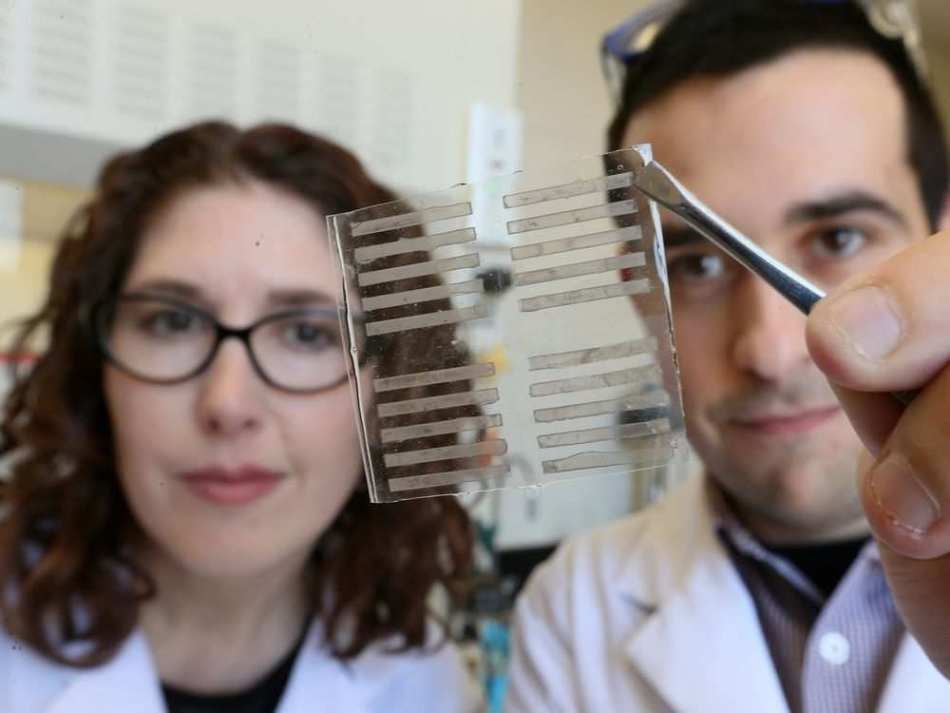Mar 20 2017
 University of Windsor professors Tricia Carmichael, left, and Simon Rondeau-Gagne hold a transparent, stretchable and wearable material in the biochemistry and chemistry departments March 15, 2017. NICK BRANCACCIO / WINDSOR STAR
University of Windsor professors Tricia Carmichael, left, and Simon Rondeau-Gagne hold a transparent, stretchable and wearable material in the biochemistry and chemistry departments March 15, 2017. NICK BRANCACCIO / WINDSOR STAR
Simon Rondeau-Gagne’s University of Windsor lab is involved in researching new synthetic polymers as the first step in creating wearable electronics.
Probably in the next decade every object is going to be connected through the Internet. There’s a want for smart electronics. Stretchable electronics will be an important piece of the Internet of things. Once we have a material that is stretchable, robust enough to take repeated use and can self-repair, the potential is whatever industry’s designers can imagine.
Simon Rondeau-Gagne, Assistant Chemistry Professor, University of Windsor
Rondeau-Gagne accepted an assistant chemistry professor’s position at Windsor last July after completing his post-doctoral work at Stanford University.
With his expertise in designing synthetic materials, Rondeau-Gagne joins with Professor Tricia Carmichael, who already has a well-established international reputation for her contribution in the stretchable electronics field, for this current research.
Carmichael, a researcher at IBM’s headquarters in Armonk, New York prior to returning to her hometown in 2005, stated that the two research teams possess complimentary skill sets.
“My team’s strength is we’re good at building things and working with different materials and integrating them into stretchable electronics that are stable and maintain their functionality,” Carmichael said. "Simon is an expert in synthesizing different materials and designing them for different functions. Together we can do stuff that no one has ever done before.”
Apart from smart clothing that are capable of real time monitoring of the body’s condition, Rondeau-Gagne visualizes possibilities such as new materials in car doors that self-repair after being dented or stretchable electronics helping re-establish the electrical impulse connections in a damaged spinal cord.
I think one of the emerging uses will be in elder care. It allows for constant monitoring of pulse, blood pressure, sweat or where they are. However, there are still huge challenges to doing all these things.
Tricia Carmichael, Professor, University of Windsor
Carmichael oversees a team of nine student researchers.
The first step is for Rondeau-Gagne to locate the precise material. Rondeau-Gagne explained that the efforts of his research team of six students are similar to constructing a foundation for stretchable electronics.
“It’s like sci-fi stuff,” said Rondeau-Gagne, a native of Chicoutimi-Saguenay. “The material I’m working with looks like ink, but when it’s solid it looks like blue plastic. It makes a film, but it’s only 40 Nano-millimeters thick.”
Rondeau-Gagne already has already managed to create a polymer comprising of transistors that could be ‘re-healed’ with heat.
He aims to quickly complete development of self-healing materials that do not require an external stimulus to allow Carmichael to use her skill in stretchable electronics.
I believe within a year we’ll reach that point. Tricia has a real expertise in these electronic devices and stretchable materials. She’s had great results already using rubber materials.
Simon Rondeau-Gagne, Assistant Chemistry Professor, University of Windsor
In fact Carmichael’s team has already developed a new type of rubber. It is clear and impermeable to gases and was a variation of the rubber used to line the inner side of car tires.
“What we were able to do is develop a transparent version of this material,” Carmichael said. “That means we make displays to use in it.”
However, the eventual goal is to locate a synthetic compound that can take repeated use, is more stretchable, self-repairs, and can endure the heat produced by the transistors and circuitry placed within it.
“We already have materials that can be stretched 100 per cent,” Rondeau-Gagne said.
“However, even if it can stretch 10,000 per cent, if it can’t be stretched more than a couple times without the circuit breaking, we can’t use it. There’s going to be pressure and stretching all the time with wearable electronics.”
Carmichael said the domain of stretchable electronics is developing quickly with increasing investment from top foundations and corporations.
Simple demos (of stretchable electronics) are real. There’s a huge community who make wearable electronics by sewing things into their clothes. There’s already a cottage industry. I visited a wearable electronics company in Toronto making real products – sweat sensors for clothing. It’s coming.
Tricia Carmichael, Professor, University of Windsor